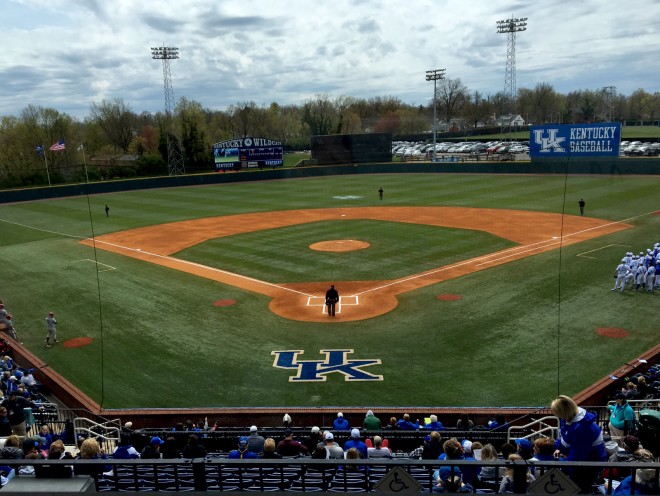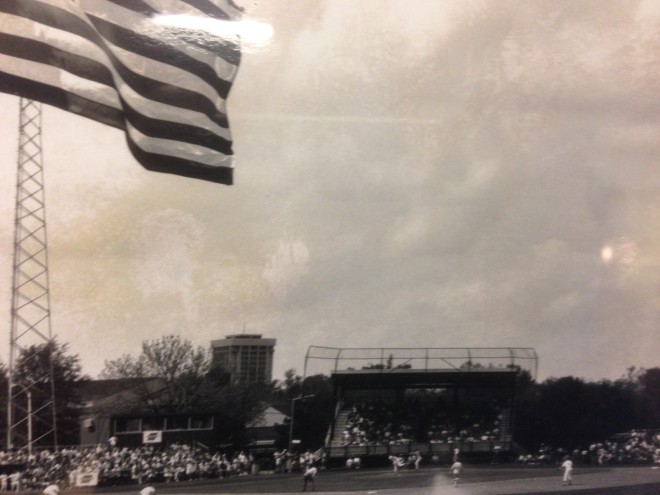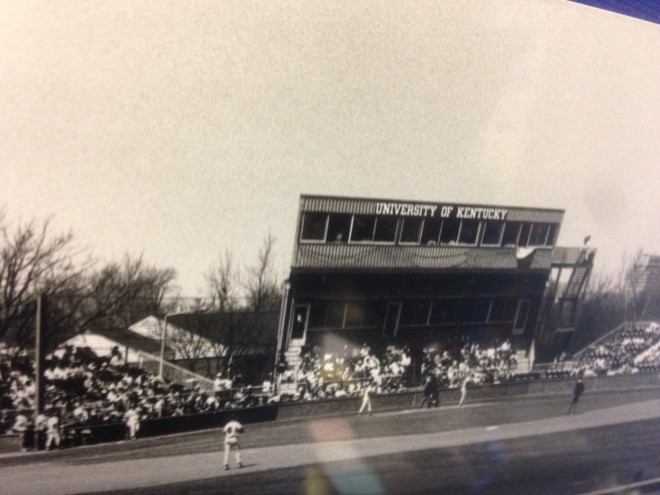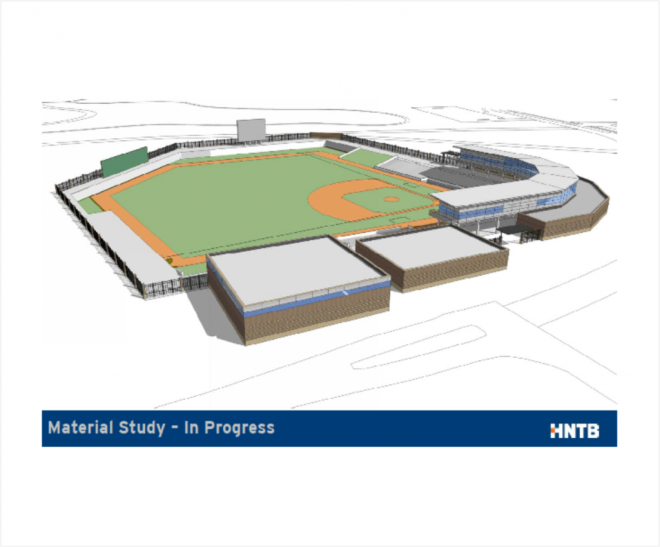How UK baseball is catching up financially after years of disregard
The wind whips across Cliff Hagan Stadium on a frigid day in early March. The playing surface is a baseball purists dream. Natural grass makes up every inch of fair territory and real dirt is spread on the infield and base paths.
But on this day, when the University of Kentucky baseball team won its 663rd game at “The Cliff” with a 3-2 victory over Austin Peay, the field is damp from the usual freezing and thawing of the winter. The game against Austin Peay was the team’s home opener for the 2016 season, but no fans are lined up outside the gates waiting to get in. The few fans who did show up are bundled under blankets and jackets, surrounded by empty sections of metal bleachers.

The scene can be repeated nearly every year. It embodies the challenges the Kentucky baseball team faces: poor weather early in the season and a stadium that is far outdated compared to its Southeastern Conference opponents.
The weather cannot be changed. However, years of little support from the administration has left Kentucky as a program that continually lags behind the rest of the conference in facilities.
With Kentucky unlikely to reach an NCAA regional after a 32-25 season, it looks like another season where the Wildcats won't reach postseason play. Kentucky’s streak of being the only program in the SEC to have still never made a super regional or College World Series will continue.
Meager Beginnings
When 26-year-old Keith Madison showed up to Lexington in the summer of 1978 as Kentucky’s new baseball coach, he was welcomed to a ballpark that was barely more impressive than a high school stadium. The Bernie A. Shively Sports Center (later renamed Cliff Hagan Stadium in the early 1990s) seated just 500 people at the time. It was a far cry from his comfortable job as an assistant coach at Mississippi State, which treats baseball as king.
Make no mistake, Madison was excited for the opportunity to lead the Wildcats. He was a native Kentuckian, born in Brownsville in 1951 and eventually became a star athlete at Edmonson County High School. He bounced around as a pitcher in the minor leagues after high school and eventually made it to Triple-A, the highest level of minor league baseball, before a knee injury ended his career.
Coaching became his passion and he got his career started as a high school coach at Lake Wales High School in Florida. After two years he made the leap to Mississippi State.
But here he was now in Lexington, the youngest coach in NCAA Division I baseball at a program that had no history of baseball success.
“Even though I’m excited, I look at the field and it’s almost like a recreational field or maybe a glorified high school field,” Madison said. “It wasn’t that far behind other SEC schools because the whole stadium thing hadn’t caught on at that point.”

The stadium thing would soon catch on in the conference, but not necessarily at Kentucky. The baseball program had no grounds crew at this time, so Madison and his assistants had to maintain the field. They had to cut the grass, rake the infield and chalk the baselines. Aside from taking care of the field, Madison also had to do the thing he was hired to do—coach the team. He and his staff recruited full time and also had to promote the program themselves as the baseball team didn’t have a sports information staff at that time.
“I’m not saying this to pat myself on the back or anything like that, but we put in 14 hour days at the stadium because we just didn’t have help,” Madison said.
While the playing surface itself was nothing special, the overall facility wasn’t much better. A concrete building was half equipment storage and the other half, on top of the building, was a press box.
Other schools started to improve their stadiums and Madison knew he had to do something to keep up in recruiting. If not, he risked falling behind his peers and not being able to catch up.
Financial support waivers
In order to keep up with the rest of the conference, Madison intended to break renovations down into three different plans. He first wanted to put in permanent seating so the field would have more of a stadium feel. This phase also included a new, bigger press box at the ballpark.
When Madison went to discuss the plans with then-athletic director Cliff Hagan, he was met with a surprising answer.
“I told him, ‘We’re getting absolutely smoked by our competition and we’re already the northernmost school in the league, our weather’s not as good as the southern schools. We didn’t have a full allotment of assistant coaches like the other schools to do.
“They basically said, you want it, go out and raise money,” Madison said. “You have to do it yourself.”
So he did. Madison and his staff were able to raise $250,000 for the installation of lights in 1987 and later raised $520,000 for renovations that refurbished the stadium in 1990.

He would later raise $2.5 million for the renovations in 2002. The stadium added 2,000 chairback seats, a new press box and television booth and two luxury skyboxes.
Madison did almost all of the fundraising to improve the stadium to its current state. He acknowledges that it was tough to receive little financial support from the athletic department.
“I’d like to tell you that it didn’t bother me but there were times it did bother me,” Madison said. “But I wanted so badly to help Kentucky get to the next level in baseball that I just put my nose to the grindstone and kept going. It’s one of those things where you can either get bitter or you can get better. I chose to try to get better.”
Madison's ending and a new beginning
Madison averaged 28 wins per year in his 25 years as the head coach at Kentucky, but toward the end of his tenure the program started to slip. Before his resignation in 2003, the Wildcats had struggled for three years. It was in 2002 that current athletic director Mitch Barnhart was hired.
Madison was stretched thin from raising fundraising for the stadium renovation and coaching, so Barnhart told him to stop fundraising and focus on coaching. While Barnhart and Madison only worked together for only one year, Madison wishes Barnhart would have been there longer.
“I wish Mitch Barnhart would’ve been here the last 15 years of my career,” Madison said. “I see the energy and the way he supports all the programs, not just basketball and football. It’s refreshing to see that. If there’s a need, he and his staff go out and take care of that need. I tip my hat to Mitch and all he’s done for the sports other than football and basketball.”
In an email, Barnhart said much of the infrastructure in place is because of Madison’s work.
“Coach Madison deserves so much credit for his dedication to the game of baseball and the University of Kentucky,” Barnhart said. “It is always our goal to match resources to expectations and we want to make sure our students have the opportunity to compete in the SEC on a level footing. From a budget and support perspective, we have done that. We must now fulfill the last piece of that resource package with the stadium.”
Arms Race
In May 2013, SEC commissioner Mike Slive reached a deal with ESPN to create the SEC Network. The network has programming for 21 different sports, which has been great for exposure in the conference. However, the key part of the network is the amount of money that it brings to the conference.
The SEC Network officially launched in August 2014 and the schools in the conference benefitted immediately. Each school received $31.2 million from the network. The increased revenue for schools means they have more money to put into facilities for various sports. Several SEC universities have begun renovating their facilities at a much faster rate than what they had done previously.
However, one program that has always stayed up to date on renovations is Arkansas. Arkansas has been among the conference’s best baseball programs since joining the SEC in 1990. The Razorbacks have been the to the NCAA Tournament 28 times in their history and have gone to the tournament every year since 2002.
The success of the Arkansas program has translated into one of the nicest stadiums in all of college baseball. Arkansas played its first game in Baum Stadium in 1996 and the stadium has been ranked among the nation’s best stadiums multiple times. Baseball America magazine named Baum Stadium the nicest in the country in 1998. Rivals.com named Baum Stadium as the nicest ballpark once again in 2008.

One reason Baum Stadium continues to garner so much national acclaim is because of its renovations. The stadium underwent four renovations from 2003-2014. For reference, Cliff Hagan Stadium has only added a new video board and a new porch was built in right centerfield during that time.
The list of other SEC schools that have renovated their stadiums or built a new stadium since Kentucky’s last renovation in 2002 is lengthy. South Carolina’s Founders Park seats 8,242 people and was built in 2009. It’s considered as one of the top ballparks in all of college baseball.
Alabama reconstructed Thomas-Sewell Stadium for $42 million. It’s called “The New Joe” and was opened in time for the 2016 season. LSU moved into Alex Box Stadium, which seats 10,000 people, in 2009. The Tigers annually lead the nation in attendance.
The common theme with these teams is they traditionally win, which could lead to more renovations. For example, Vanderbilt won the College World Series in 2014 and was the national runner-up in 2015. In June of 2015, Vanderbilt announced its plans to build a $12 million baseball facility.
Ole Miss made the College World Series in 2014. It was the Rebels first appearance in Omaha since 1972. Earlier this year, the school announced its plans for a $13 million renovation to Oxford-University Stadium/Swayze Field.
“I think baseball fans in Kentucky would be shocked if they went to a baseball game at the University of South Carolina, or LSU, or Alabama, or Arkansas,” Madison said. “Because there will be 7-8,000 fans in Triple-A type stadiums. It’s a very, very important sport in those places.”
Plans for a new stadium
Kentucky’s athletic department has tried to build a new stadium for several years, but it’s had difficulty doing so. Often the stadium has run into financial problems or other sports were more of a pressing need.
In 2013, Kentucky softball’s John Cropp stadium underwent a $9.5 million renovation and the soccer complex, which is connected to softball, underwent a $7.7 million remodel in the same year. Meanwhile, Commonwealth Stadium, home of the Kentucky football team, underwent renovations and a new practice facility is also being built. It’s set to open prior to the 2016 season.
Kentucky also opened a new track and field complex in 2012. So while baseball has been needing a new facility, the other sports listed took precedence over the new stadium. This has led some baseball fans to believe baseball has been less of a priority, but Barnhart said this is not true.
“Building a baseball stadium has never been on the back burner, but we have had to set priorities with a list of needed facility improvements that was so long just a few years ago,” Barnhart said. “We have been innovative and flexible in addressing pressing needs for track, softball, soccer and football and now that we have gotten that done, our focus has shifted to baseball.”

Barnhart said now is the time for the baseball team to get a new stadium, but some hurdles remain. The athletic director said Kentucky is working toward securing approval to move forward with the project this summer.
Getting approval has been a challenge.
“Though we remain self-sufficient, operating with no state or university funds and with limited revenue from student fees, we operate in the context of a larger system at both the state and university level,” Barnhart said. “We know how to navigate the challenges that come with that, but that process takes time. Because of that system and the fact that we fund our own facility improvements and have historically carried little debt, we have had to address our facility needs on a piecemeal basis.”
The new stadium will be built off Alumni Drive and adjacent to the softball and soccer complex. The plan for the stadium now is to seat 2,500 people and the price range will be around $30-40 million. According to Barnhart, the new baseball stadium will be a state-of-the-art venue that will put Kentucky on par with the best facilities in the Southeastern Conference.
A new stadium won’t mean Kentucky will instantly start winning super regionals, but it will likely help the Wildcats in recruiting. Kentucky currently has the No. 14 rated baseball class for 2016 by Perfect Game, so the club has been able to recruit at a high level despite average facilities.
Tanner Johnson is a catcher from South Oldham High School who is committed to Kentucky in the 2017 class. Upon committing to Kentucky in January, head coach Gary Henderson and his assistants took him to the location of the new baseball stadium. The new stadium was a major factor in his decision to stay home to play baseball, Johnson said.
“I think it’s going to be big the next few years getting a stadium and rewrite what people know about Kentucky,” Johnson said.
The end of an era
Early projections have Kentucky starting construction on the new stadium in 2017. The plan is to tear down the current stadium and build a new tennis facility. For former head coach Madison, it will represent the end of nearly 40 years of memories.
“I’m probably going to cry like a baby when it happens because when they leave Cliff Hagan Stadium, there’s been a lot of memories and a lot of blood, sweat and tears that have been spilled there,” Madison said. “But (a new stadium) is the right thing to do. It’s needed. It is overdue. Mitch Barnhart will be the first to tell you it’s overdue.”
You can follow Cats Illustrated reporter Derek Terry on Twitter @DTerryRivals.
